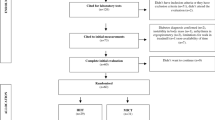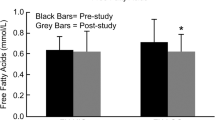Abstract
This study was performed to establish whether only 2 sessions per week of combined aerobic and resistance exercise are enough to reduce glycated hemoglobin (HbA1c) and to induce changes in skeletal muscle gene expression in Type 2 diabetes mellitus (DM2) subjects with metabolic syndrome. Eight DM2 subjects underwent a 1-yr exercise program consisting of 2 weekly sessions of 140 min that combined aerobic [at 55–70% of maximal oxygen uptake (VO2max)] and resistance circuit training [at 60–80% of 1 repetition maximum (RM)]. The training significantly improved VO2max) (from 33.5±3.8 ml/kg/min to 38.2±3.5 ml/kg/min, p=0.0085) and muscle strength (p<0.05). Changes over baseline were significant for HbA1c, reduced by 0.45% (p=0.0084), fasting blood glucose (from 8.8±1.5 to 6.9±2.2 mmol/l, p=0.0132), waist circumference (from 98.9±4.8 to 95.9±4.6 cm, p=0.0054), body weight (from 87.5±10.7 to 85.7±10.1 kg, p=0.0375), systolic blood pressure (from 137±15 to 126±8 mmHg, p=0.0455), total cholesterol (from 220±24 to 184±13 mg/dl, p=0.0057), and LDL-cholesterol (from 150±16 to 105±15 mg/dl, p=0.0004). Mitochondrial DNA/nuclear DNA ratio at 6 and 12 months did not change. There was a significant increase of mRNA of peroxisome proliferator-activated receptor (PPAR)-γ after 6 months of training(p=0.024); PPARα mRNA levels were significantly increased at 6 (p=0.035) and 12 months (p=0.044). The mRNA quantification of other genes measured [mitochondrially encoded cytochrome c oxidase subunit II (MTCO2), cytochrome c oxidase subunit Vb (COX5b), PPARγ coactivator 1α (PGC-1α), glucose transporter 4 (GLUT 4), forkhead transcription factor BOX O1 (FOXO-1), carnitine palmitoyltransferase 1 (CPT-1), lipoprotein lipase (LPL), and insulin receptor substrate 1 (IRS-1)] did not show significant changes at 6 and 12 months. This study suggests that a twice-per-week frequency of exercise is sufficient to improve glucose control and the expression of skeletal muscle PPARγ and PPARα in DM2 subjects with metabolic syndrome.
Similar content being viewed by others
References
Sigal RJ, Kenny GP, Wasserman DH, Castaneda-Sceppa C, White RD. Physical activity/exercise and type 2 diabetes: a consensus statement from the American Diabetes Association. Diabetes Care 2006, 29: 1433–8.
Snowling NJ, Hopkins WG. Effect of different modes of exercise training on glucose control and risk factors for complication in type 2 diabetic patients. Diabetes Care 2006, 29: 2518–27.
Pedersen BK, Saltin B. Evidence for prescribing exercise as therapy in chronic disease. Scand J Med Sci Sports 2006, 16 (Suppl. 1): 3–63.
De Feo P, Stocchi V. Physical activity for the treatment and prevention of metabolic syndrome. Nutr Metab Cardiovasc Dis 2007, 17: 327–31.
Haskell WL, Lee IM, Pate RR, et al. Physical Activity and Public Health: Updated recommendations for adults from the American College of Sports Medicine and the American Heart Association. Circulation 2007, 116: 1081–93.
Marwick TH, Hordern MD, Miller T, et al.; Council on Clinical Cardiology, American Heart Association Exercise, Cardiac Rehabilitation, and Prevention Committee; Council on Cardiovascular Disease in the Young; Council on Cardiovascular Nursing; Council on Nutrition, Physical Activity, and Metabolism; Interdisciplinary Council on Quality of Care and Outcomes Research. Exercise training for type 2 diabetes mellitus: impact on cardiovascular risk: a scientific statement from the American Heart Association. Circulation 2009, 119: 3244–62.
Di Loreto C, Fanelli C, Lucidi P, et al. Validation of a counseling strategy to promote the adoption and the maintenance of physical activity by type 2 diabetic subjects. Diabetes Care 2003, 26: 404–8.
Di Loreto C, Fanelli C, Lucidi P, et al. Make your diabetic patients walk: long-term impact of different amounts of physical activity on type 2 diabetes. Diabetes Care 2005, 28: 1295–302.
Kirk A, De Feo P. Strategies to enhance compliance to physical activity for patients with insulin resistance. Appl Physiol Nutr Metab 2007, 32: 549–56.
Ibañez J, Izquierdo M, Argüelles I, et al. Twice-weekly progressive resistance training decreases abdominal fat and improves insulin sensitivity in older men with type 2 diabetes. Diabetes Care 2005, 28: 662–7.
Honkola A, Forsén T, Eriksson J. Resistance training improves the metabolic profile in individuals with type 2 diabetes. Acta Diabetol 1997, 34: 245–8.
Brun JF, Bordenave S, Mercier J, Jaussent A, Picot MC, Préfaut C. Cost-sparing effect of twice-weekly targeted endurance training in type 2 diabetics: a one-year controlled randomized trial. Diabetes Metab 2008, 34: 258–65.
Sigal RJ, Kenny GP, Boulé NG, et al. Effects of aerobic training, resistance training, or both on glycemic control in type 2 diabetes: a randomized trial. Ann Intern Med 2007, 147: 357–69.
Baron AD, Brechtel G, Wallace P, Edelman SV. Rates and tissue sites of non-insulin- and insulin-mediated glucose uptake in humans. Am J Physiol 1988, 255: E769–74.
Balducci S, Zanuso S, Massarini M, et al. The Italian Diabetes and Exercise Study (IDES): Design and methods for a prospective Italian multicentre trial of intensive lifestyle intervention in people with type 2 diabetes and the metabolic syndrome. Nutr Metab Cardiovasc Dis 2008, 18: 585–95.
Balke B, Ware R. An experimental study of physical fitness of Air Force personnel. US Armed Forces Med J 1959; 10: 675–88.
Guescini M, Fatone C, Stocchi L, et al. Fine needle aspiration coupled with real-time PCR: A painless methodology to study adaptive functional changes in skeletal muscle. Nutr Metab Cardiovasc Dis 2007, 17: 383–93.
Pfaffl MW. A new mathematical model for relative quantification in real-time RT-PCR. Nucleic Acids Res 2001, 29: e45.
Malden MA, Zar JH. Biostatistical Analysis (Second Edition). Englewood Cliffs: Prentice-Hall, 1984.
General principles of exercise prescription. In: Johnson EP Ed. ACSM’s guidelines for exercise testing and prescription, 6th ed. Baltimore: Lippincott Williams & Wilkins. 2000, 137–64.
Lee CH, Olson P, Evans RM. Lipid metabolism, metabolic disease, and peroxisome proliferators-activated receptors. Endocrinology 2003, 144: 2201–7.
Bragt MCE, Popeijus HE. Peroxisome proliferator-activated receptors and the metabolic syndrome. Physiol Behav 2008, 94: 187–97.
Toledo FGS, Menshikova EV, Ritov VB, et al. Effects of physical activity and weight loss on skeletal muscle mitochondria and relationship with glucose control in Type 2 diabetes. Diabetes 2007, 56: 2142–7.
Kelly DP, Scarpulla RC. Transcriptional regulatory circuits controlling mitochondrial biogenesis and function. Genes Dev 2004, 18: 357–68.
Hood DA, Irrcher I, Ljubicic V, Joseph AM. Coordination of metabolic plasticity in skeletal muscle. J Exp Biol 2006, 209: 2265–75.
Lin J, Handschin C, Spiegelman BM. Metabolic control through the PGC-1 family of transcription coactivators. Cell Metab 2005, 1: 361–70.
Finck BN, Kelly DP. PGC-1 coactivators: inducible regulators of energy metabolism in health and disease. J Clin Invest 2006, 116: 615–22.
Garnier A, Fortin D, Zoll J, et al. Coordinated changes in mitochondrial function and biogenesis in health and diseased human skeletal muscle. FASEB J 2005, 19: 43–52.
Hoppeler H, Fluck M. Plasticity of skeletal muscle mitochondria: structure and function. Med Sci Sports Exerc 2003, 35: 95–104.
Kim HJ, Lee JS, Kim CK. Effect of exercise training on muscle glucose transporter 4 protein and intramuscular lipid content in elderly men with impaired glucose tolerance. Eur J Appl Physiol 2004, 93: 353–8.
Kovacs P, Hanson RL, Lee YH, et al. The role of insulin receptor substrate-1 gene (IRS1) in type 2 diabetes in Pima Indians. Diabetes 2003, 52: 3005–9.
Accili D, Arden KC. FoxOs at the crossroads of cellular metabolism, differentiation, and transformation. Cell 2004, 117: 421–6.
Puigserver P, Rhee J, Donovan J, et al. Insulin-regulated hepatic gluconeogenesis through FOX01-PGC-1 alpha interaction. Nature 2003, 423: 550–5.
Pilegaard H, Saltin B, Neufer PD. Exercise induces transient transcriptional activation of the PGC-1 alfa gene in human skeletal muscle. J Physiol 2003, 546: 851–8.
Kraniou GN, Cameron-Smith D, Hargreaves M. Effect of short-term training on GLUT-4 mRNA and protein expression in human skeletal muscle. Exp Physiol 2004, 89: 559–63.
Author information
Authors and Affiliations
Corresponding author
Rights and permissions
About this article
Cite this article
Fatone, C., Guescini, M., Balducci, S. et al. Two weekly sessions of combined aerobic and resistance exercise are sufficient to provide beneficial effects in subjects with Type 2 diabetes mellitus and metabolic syndrome. J Endocrinol Invest 33, 489–495 (2010). https://doi.org/10.1007/BF03346630
Accepted:
Published:
Issue Date:
DOI: https://doi.org/10.1007/BF03346630




